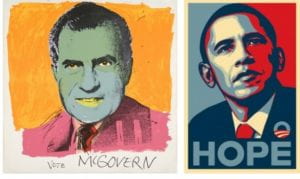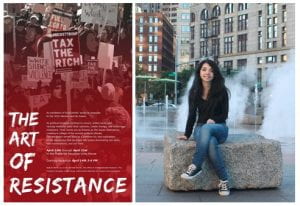Research in Art History and Curatorial Studies
Artistic Responses to Presidential Elections and other Political Challenges
By Mariah Tarentino
The United States has a rich history of politically motivated art, from the first political cartoons of the American Revolution to the socially conscious artists involved in civil rights movements of the 1950s and 60s and leading up to works of today disseminated on social media and as street art. In 1972 Andy Warhol created “Vote McGovern” for the George McGovern Presidential campaign. Rather than portraying McGovern, Warhol decided to represent his opponent in a negative light. During the 2008 elections, the Barack Obama “Hope” poster–designed by the renowned graffiti artist Shepard Fairey–was widely described as iconic and came to represent the 2008 presidential campaign. The image became one of the most important aspects of Obama’s campaign messages, and arguably affected the perception of Obama in a positive way. By contrast, graffiti art and posters of President-elect Donald Trump, produced by designers and graffiti artists, were largely negative. Why do artists react to presidential elections? How does art affect the decision of voters? What can we learn from these artistic interventions? By looking at the trajectory of these artistic responses, we can better understand the relationship between art and politics: the ways in which art making can have an impact on the general public and how art becomes a tool of resistance for political dissidents.

Left: Andy Warhol’s “Vote McGovern.” Courtesy of MOMA. Available at https://www.moma.org/collection/works/68705 © MOMA; right: Shepar Fairy’s “Hope.” Courtesy of Wikimedia. Available at https://upload.wikimedia.org/wikipedia/en/5/55/Barack_Obama_Hope_poster.jpg © Wikimedia.
In the 2016-17 polarized election cycle in the US, artists used their platforms to make a stand for their beliefs. The political art of the past year has come to the forefront of protests, awareness campaigns and the like. This art has focused on a wide range of themes, from women’s rights, racial justice, LGBTQ+ rights, and criticism of the economy, to foreign policy, and politicians themselves.
These depictions of political issues have clear and cutting messages. Through examining the works of artists, one can gain greater insight into the current unrest within our nation. And by analyzing what makes political art effective in its goals, artists can gain greater understanding of how to successfully use their skills to become an activist who is engaged in the society.
§
My fascination with the topic of artistic responses to Presidential elections and other political challenges is owing to my interest in art and activism. I major in Art History with a minor in Women’s and Gender Studies. In the past three years, I have been a student employee at the Center for Women, Gender, and Sexuality (CWGS) at UMass Dartmouth. During my time at CWGS, I have been involved in multiple projects, including facilitating bystander intervention training and organizing awareness campaigns for issues like street harassment, domestic violence, and sexual assault. Additionally, I have had the opportunity to attend conferences on reproductive justice, which instilled in me a sense of civic duty and activism. In April 2015, I combined my passion of art and social issues through an exhibition featuring the art of sexual violence survivors. Through this exhibition process, I saw firsthand the power art has to convey powerful messages. I have seen this again in the current political climate. As the University of Massachusetts has a respected art college and a strong sense of civic and community engagement, it seems appropriate to conduct a research on the topic of art as activism and the role of the artist as an activist. In what follows, I provide a summary of my research, which was supported by a generous fund from the OUR, granted to me in Spring 2017.
§
2016 was a year of rising socio-political tensions, which the election only seemed to bring to a boiling point. Between the Dakota Access Pipeline, Flint, Michigan still in need of clean water, arguments of religious freedom and gay rights, the disentrancement of the working class, and the ever-growing list of innocent Black Americans killed at the hands of police- everyone seemed in agreement that something had to give, but few agreed on what. The country held its breath as election results trickled in and a collectively exhaled, some in relief and some in shock, when Mr.Trump became President Trump. In all this unrest and apprehensiveness, art found itself in the center of the conversation.
Art worked to facilitate debate and convey messages, and it varied as much as the issues it attempted to address. It was seen on protest signs, in art museums, and on the internet. However, the common thread appeared to be that the art made use of appropriation and irony to convey its messages; it referenced images and messages of the oppressor, in part to illuminate the wrongs and in part to reclaim the very same images. Saint Hoax’s Make America Misogynistic Again is a prime example in this vein.
I was most interested in the protest images that came out of the election and inauguration. My OUR funded research consisted of two parts: 1) a research paper that examined this political art and attempted to place it in a broader historical context; 2) an exhibition of local artists’ works regarding the 2016 elections. The Frederick Douglass Unity House at UMass Dartmouth was gracious enough to host my exhibition (The Art of Resistance). The goals and values of the Unity House in creating discussion, providing support, and educating the community aligned perfectly with my goals for this exhibition.

Left: Poster of “The Art of Resistance,” a juried show designed and curated by Mariah Tarentino; right: Portrait of Mariah Tarentino near the Public Art Projects at the Rose Kennedy Greenway in Boston.
§
My show facilitated a dialogue at the time when political issues effected our campus community and other surrounding communities we all belong to. It also gave students a platform to discuss politics in unique and creative ways. In my call to artists, I tried to keep submission guidelines as open as possible. I hoped that the exhibit would inspire and empower others to act, be it through art, protest, calling representatives, or other avenues. The exhibition took place in mid-April and featured the works of students Ashley Lima, Joel Rivera, Grace Augello, Shannon Morrell, and Chloe Bartlett, and alumni Johnus Derby. It included photographs, paintings, digital works, and protest signs. The diversity of the works on display was a small glimpse into the diversity of works from artists around the country.
Additionally, I wrote a paper analyzing works from all election cycles reaching from 2016 to Nixon. The paper revealed trends not only in art, but also in politics; through multiple case studies I discussed the ways in which artists and creative agents have approached political issues and described how they have chosen to agree or disagree. The research conducted for this paper allowed me to craft a theme for the 2017 UMass Dartmouth Art History Annual Undergraduate Symposium: Art and Activism. In my capacity as the President of the Art History Club, I was responsible for organizing this year’s symposium, which required coming up with a theme.
The research grant from the OUR also allowed me to advance my career goals by enabling my extra-curricular activities in the Department of Art History and I am grateful for that. The funding facilitated a professional exhibition with ample publicity. It also provided support for my research at key libraries in the greater Boston area. I intend to attend graduate school in curatorial and museum studies. Eventually, I’d like to pursue a career in curation, featuring the works of artists who focus on challenging social and political issues.

